NCERT Solutions for Class 9 Science Chapter 9 Force and Laws of Motion
NCERT Solutions for Class 9 Science (physics) Chapter 9 Force and Laws of Motion are given below. In these solutions, we have answered all the intext and exercise questions provided in NCERT class 9 science textbook. Class 9 NCERT Solutions Science Chapter 9 provided in this article are strictly based on the CBSE syllabus and curriculum. Students can easily download these solutions in PDF format for free from our app.
Class 9 Science Chapter 9 Textbook Questions and Answers
INTEXT QUESTIONS
PAGE NO-118
Question 1: Which of the following has more inertia: (a) a rubber ball and a stone of the same size? (b) a bicycle and a train? (c) a five-rupees coin and a one-rupee coin?
Answer: Inertia is the measure of the mass of the body. The greater is the mass of the body; the greater is its inertia and vice-versa.
(a) Mass of a stone is more than the mass of a rubber ball for the same size. Hence, inertia of the stone is greater than that of a rubber ball.
(b) Mass of a train is more than the mass of a bicycle. Hence, inertia of the train is greater than that of the bicycle.
(c) Mass of a five rupees coin is more than that of a one-rupee coin. Hence, inertia of the five rupees coin is greater than that of the one-rupee coin.
Question 2: In the following example, try to identify the number of times the velocity of the ball changes:
“A football player kicks a football to another player of his team who kicks the football towards the goal. The goalkeeper of the opposite team collects the football and kicks it towards a player of his own team”.
Also identify the agent supplying the force in each case.
Answer: The velocity of football changes four times. First, when a football player kicks to another player, second when that player kicks the football to the goalkeeper. Third when the goalkeeper stops the football. Fourth when the goalkeeper kicks the football towards a player of his own team. Agent supplying the force –First case – First player Second case – Second player Third case – Goalkeeper Fourth case – Goalkeeper
Question 3: Explain why some of the leaves may get detached from a tree if we vigorously shake its branch.
Answer: When the branch of the tree is shaken, the branch moves in a to-and-fro motion. However, the inertia of the leaves in attached to the branch resists the motion of the branch. Therefore, the leaves that are weakly attached to the branch fall off due to inertia whereas the leaves that are firmly attached to the branch remain attached.
Question 4: Why do you fall in the forward direction when a moving bus brakes to a stop and fall backwards when it accelerates from rest?
Answer: In a moving bus, passengers are in motion along with bus. When brakes are applied to stop a moving bus, bus comes in the position of rest. But because of tendency to be in the motion a person falls in forward direction. Similarly, when a bus is accelerated from rest, the tendency to be in rest, a person in the bus falls backwards.
PAGE NO 126-127
Question 1: If action is always equal to the reaction, explain how a horse can pull a cart.
Answer: A horse pushes the ground in the backward direction. According to Newton’s third law of motion, a reaction force is exerted by the Earth on the horse in the forward direction. As a result, the cart moves forward.
Question 2: Explain, why is it difficult for a fireman to hold a hose, which ejects large amounts of water at a high velocity.
Answer: When large amount of water is ejected from a hose at a high velocity, according to Newton’s Third Law of Motion, water pushes the hose in backward direction with the same force. Therefore, it is difficult for a fireman to hold a hose in which ejects large amount of water at a high velocity.
Question 3: From a rifle of mass 4 kg, a bullet of mass 50 g is fired with an initial velocity of 35 . Calculate the initial recoil velocity of the rifle.
Answer: Mass of the rifle, m1 = 4 kg
Mass of the bullet, m2 = 50g = 0.05 kg
Recoil velocity of the rifle = v1
Bullet is fired with an initial velocity, v2 = 35 m/s
Initially, the rifle is at rest.
Thus, its initial velocity, v = 0
Total initial momentum of the rifle and bullet system = (m1 + m2)v = 0
Total momentum of the rifle and bullet system after firing:
= m1v1 + m2v2
= 4(v1) + 0.05×35
= 4v1 + 1.75
According to the law of conservation of momentum:
Total momentum after the firing = Total momentum before the firing
⇒ 4v1 + 1.75 = 0
⇒ v1 = -1.75/4
⇒ v1 = – 0.4375 m/s
The negative sign indicates that the rifle recoils backwards with a velocity of 0.4375 m/s.
Question 4: Two objects of masses 100g and 200g are moving along the same line and direction with velocities of 2 and 1 , respectively. They collide and after the collision, the first object moves at a velocity of 1.67 . Determine the velocity of the second object.
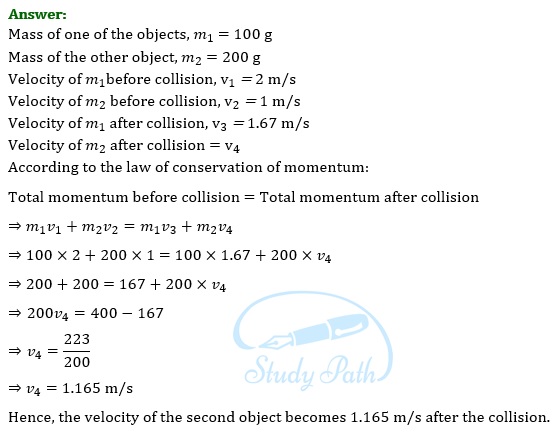
EXERCISE
Question 1: An object experiences a net zero external unbalanced force. Is it possible for the object to be travelling with a non-zero velocity? If yes, state the conditions that must be placed on the magnitude and direction of the velocity. If no, provide a reason.
Answer: Yes, it is possible. An object moving in some direction with constant velocity will continue in its state of motion as long as there are no external unbalanced forces acting on it. In order to change the motion of the object, some external unbalanced force must act upon it.
Question 2: When a carpet is beaten with a stick, dust comes out of it. Explain.
Answer: Inertia of an object tends to resist any change in its state of rest or state of motion. When a carpet is beaten with a stick, then the carpet comes to motion. But, the dust particles try to resist their state of rest. According to Newton’s first law of motion, the dust particles stay in a state of rest, while the carpet moves. Hence, the dust particles come out of the carpet.
Question 3: Why is it advised to tie any luggage kept on the roof of a bus with a rope?
Answer: Luggage kept on the roof of a bus has the tendency to maintain its state of rest when bus is in rest and to maintain the state of motion when bus is in motion according to Newton’s First Law of Motion. When bus will come in motion from its state of rest, in order to maintain the position of rest, luggage kept over its roof may fall down. Similarly, when a moving bus will come in the state of rest or there is any sudden change in velocity because of applying of brake, luggage may fall down because of its tendency to remain in the state of motion. This is the cause that it is advised to tie any luggage kept on the roof a bus with a rope so that luggage can be prevented from falling down.
Question 4: A batsman hits a cricket ball which then rolls on a level ground. After covering a short distance, the ball comes to rest. The ball slows to a stop because
(a) the batsman did not hit the ball hard enough.
(b) velocity is proportional to the force exerted on the ball.
(c) there is a force on the ball opposing the motion.
(d) there is no unbalanced force on the ball, so the ball would want to come to rest.
Answer: (c) There is a force on the ball opposing the motion.
Explanation: When ball moves on the ground, the force of friction opposes its movement and after some time ball comes to the state of rest.
Question 5: A truck starts from rest and rolls down a hill with a constant acceleration. It travels a distance of 400 m in 20 s. Find its acceleration. Find the force acting on it if its mass is 7 metric tonnes (Hint: 1 metric tonne = 1000 kg.)
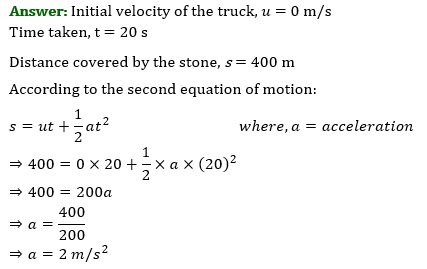
Question 6: A stone of 1 kg is thrown with a velocity of 20 m s-1 across the frozen surface of a lake and comes to rest after travelling a distance of 50 m. What is the force of friction between the stone and the ice?
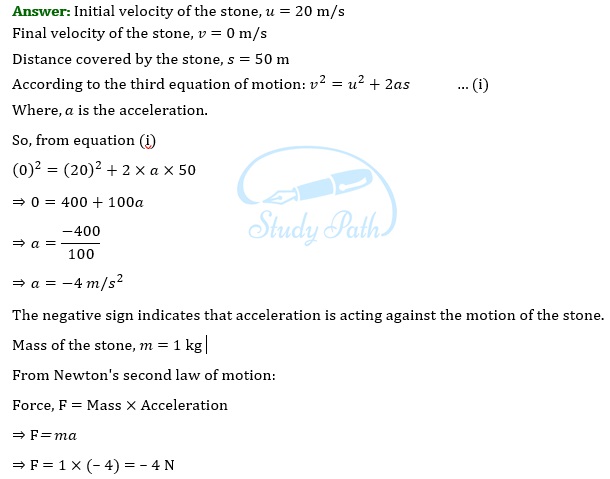
Hence, the force of friction between the stone and the ice is – 4 N. Here negative sign shows that force is being applied in the opposite direction of the movement of the stone.
Question 7: A 8000 kg engine pulls a train of 5 wagons, each of 2000 kg, along a horizontal track. If the engine exerts a force of 40000 N and the track offers a friction force of 5000 N, then calculate:
(a) the net accelerating force;
(b) the acceleration of the train
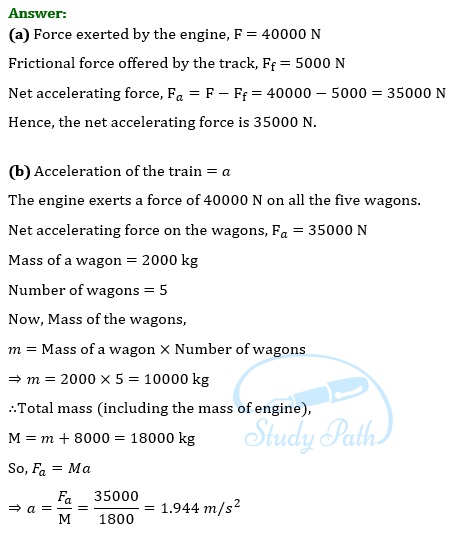
Answer: Mass of the automobile vehicle, m= 1500 kg
Final velocity, v = 0 m/s
Acceleration of the automobile, a = –1.7 ms–2
From Newton’s second law of motion:
Force = Mass × Acceleration
= 1500 × (–1.7)
= – 2550 N
Hence, the force between the automobile and the road is –2550 N, in the direction opposite to the motion of the automobile.
Question 8: An automobile vehicle has a mass of 1500 kg. What must be the force between the vehicle and road if the vehicle is to be stopped with a negative acceleration of 1.7 ms-2?
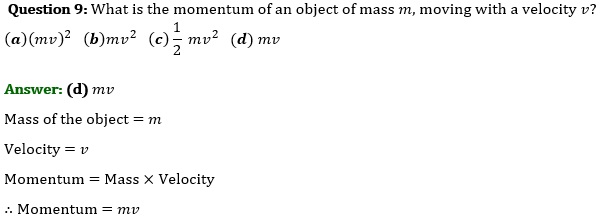
Question 10: Using a horizontal force of 200 N, we intend to move a wooden cabinet across a floor at a constant velocity. What is the friction force that will be exerted on the cabinet?
Answer: A force of 200 N is applied in the forward direction. Thus, from Newton’s third law of motion, an equal amount of force will act in the opposite direction. This opposite force is the fictional force exerted on the cabinet. Hence, a frictional force of 200 N is exerted on the cabinet.
Question 11: Two objects, each of mass 1.5 kg are moving in the same straight line but in opposite directions. The velocity of each object is 2.5 ms-1 before the collision during which they stick together. What will be the velocity of the combined object after collision?
Answer:
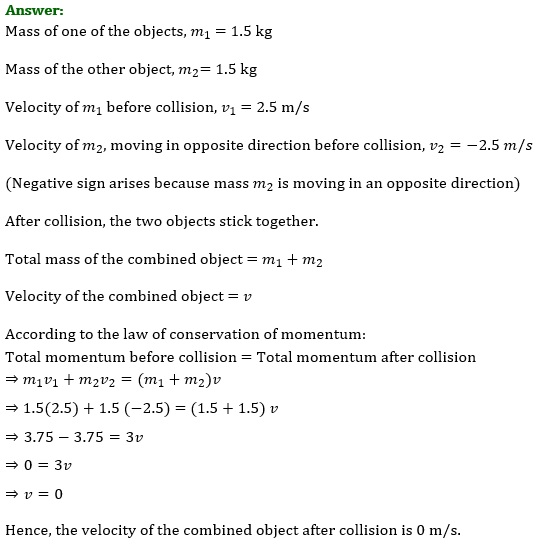
Question 12: According to the third law of motion when we push on an object, the object pushes back on us with an equal and opposite force. If the object is a massive truck parked along the roadside, it will probably not move. A student justifies this by answering that the two opposite and equal forces cancel each other. Comment on this logic and explain why the truck does not move.
Answer: Because of the huge mass of the truck, the force of static friction is very high. The force applied by the student is unable to overcome the static friction and hence he is unable to move the truck. In this case, the net unbalanced force in either direction is zero which is the reason of no motion happening here. The force applied by the student and the force because of static friction are cancelling out each other. Hence, the rationale given by the student is correct.
Question 13: A hockey ball of mass 200 g travelling at 10 m s-1 is struck by a hockey stick so as to return it along its original path with a velocity at 5 m s-1. Calculate the change of momentum occurred in the motion of the hockey ball by the force applied by the hockey stick.
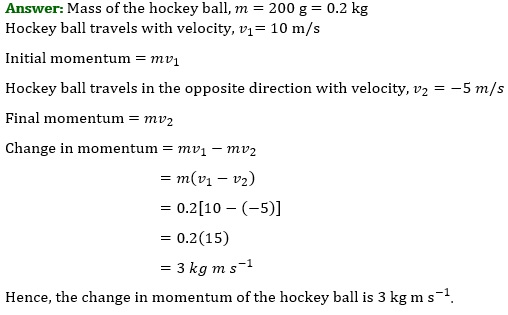
Question 14: A bullet of mass 10 g travelling horizontally with a velocity of 150 ms-1 strikes a stationary wooden block and comes to rest in 0.03 s. Calculate the distance of penetration of the bullet into the block. Also calculate the magnitude of the force exerted by the wooden block on the bullet.
Answer: Now, it is given that the bullet is travelling with a velocity of 150 m/s.
Thus, when the bullet enters the block, its velocity = Initial velocity, u = 150 m/s
Final velocity, v = 0 (since the bullet finally comes to rest)
Time taken to come to rest, t = 0.03 s
Acceleration of the bullet, a = ?
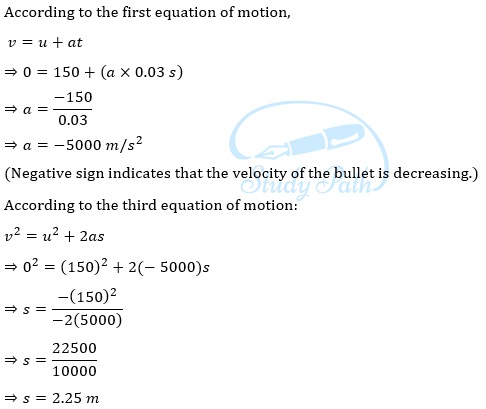
Hence, the distance of penetration of the bullet into the block is 2.25 m.
From Newton’s second law of motion:
Force, F = Mass × Acceleration
Mass of the bullet, m = 10 g = 0.01 kg
Acceleration of the bullet, a = 5000 m/s2
So, the force exerted by the wooden block on the bullet:
F = ma = 0.01×5000 = 50 N
Therefore,
Penetration of bullet in wooden block = 2.25 m
Force exerted by wooden block on bullet = – 50 N.
Here negative sign shows that force is exerted in the opposite direction of bullet.
Question 15: An object of mass 1 kg travelling in a straight line with a velocity of 10 ms-1 collides with, and sticks to, a stationary wooden block of mass 5 kg. Then they both move off together in the same straight line. Calculate the total momentum just before the impact and just after the impact. Also, calculate the velocity of the combined object.
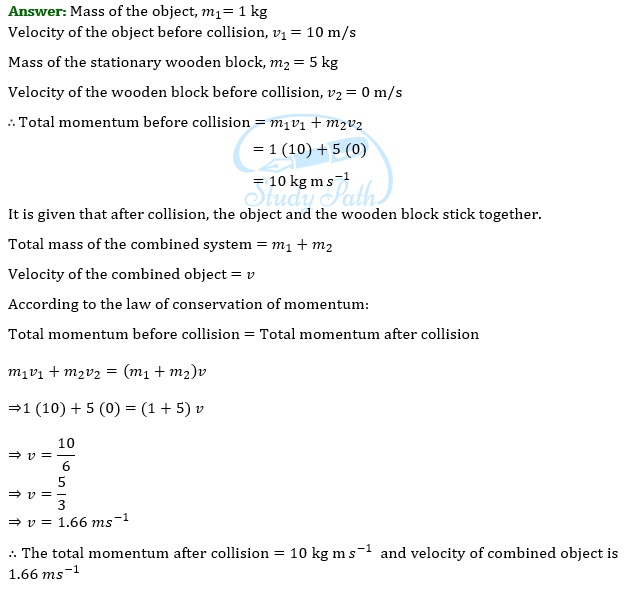
Question 16: An object of mass 100 kg is accelerated uniformly from a velocity of 5 ms-1 to 8 ms-1 in 6 s. Calculate the initial and final momentum of the object. Also, find the magnitude of the force exerted on the object.
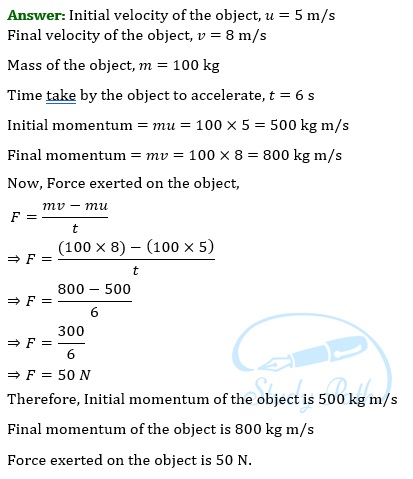
Question 17: Akhtar, Kiran and Rahul were riding in a motorocar that was moving with a high velocity on an expressway when an insect hit the windshield and got stuck on the windscreen. Akhtar and Kiran started pondering over the situation. Kiran suggested that the insect suffered a greater change in momentum as compared to the change in momentum of the motorcar (because the change in the velocity of the insect was much more than that of the motorcar). Akhtar said that since the motorcar was moving with a larger velocity, it exerted a larger force on the insect. And as a result the insect died. Rahul while putting an entirely new explanation said that both the motorcar and the insect experienced the same force and a change in their momentum. Comment on these suggestions.
Answer: According to the law of conservation of momentum:
Momentum of the car and insect system before collision = Momentum of the car and insect system after collision
Hence, the change in momentum of the car and insect system is zero.
The insect gets stuck on the windscreen. This means that the direction of the insect is reversed. As a result, the velocity of the insect changes to a great amount. On the other hand, the car continues moving with a constant velocity. Hence, Kiran’s suggestion that the insect suffers a greater change in momentum as compared to the car is correct. The momentum of the insect after collision becomes very high because the car is moving at a high speed. Therefore, the momentum gained by the insect is equal to the momentum lost by the car.
Akhtar made a correct conclusion because the mass of the car is very large as compared to the mass of the insect.
Rahul gave a correct explanation as both the car and the insect experienced equal forces caused by the Newton’s action-reaction law. But, he made an incorrect statement as the system suffers a change in momentum because the momentum before the collision is equal to the momentum after the collision.
Question 18: How much momentum will a dumbbell of mass 10 kg transfer to the floor if it falls from a height of 80 cm? Take its downward acceleration to be 10 m s-2.
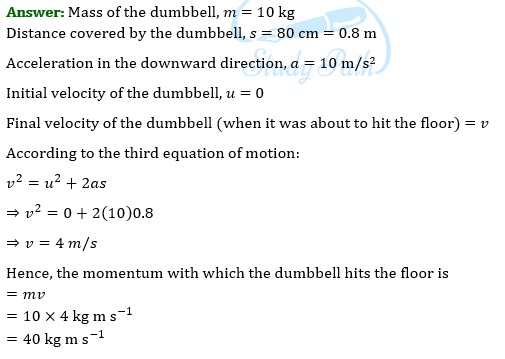
ADDITIONAL EXERCISES
Question A1: The following is the distance-time table of an object in motion:
| Times in second | Distance in meters |
| 0 | 0 |
| 1 | 1 |
| 2 | 8 |
| 3 | 27 |
| 4 | 64 |
| 5 | 125 |
| 6 | 216 |
| 7 | 343 |
(a) What conclusion can you draw about the acceleration? Is it constant, increasing, decreasing, or zero?
(b)What do you infer about the forces acting on the object?
Answer: (a) The distance covered by the object at any time interval is greater than any of the distances covered in previous time intervals. Therefore, the acceleration of the object is increasing.
(b) As per the second law of motion, force = mass × acceleration. Since the mass of the object remains constant, the increasing acceleration implies that the force acting on the object is increasing as well
Question A2: Two persons manage to push a motorcar of mass 1200 kg at a uniform velocity along a level road. The same motorcar can be pushed by three persons to produce an acceleration of 0.2 ms-2. With what force does each person push the motorcar? (Assume that all persons push the motorcar with the same muscular effort)
Answer: Mass of the motor car = 1200 kg
Only two persons manage to push the car. Hence, the acceleration acquired by the car is given by the third person alone.
Acceleration produced by the car, when it is pushed by the third person, a = 0.2 m/s2
Let the force applied by the third person be F.
From Newton’s second law of motion:
Force = Mass × Acceleration
⇒ F = 1200 × 0.2
⇒ F = 240 N
Thus, the third person applies a force of magnitude 240 N.
Hence, each person applies a force of 240 N to push the motor car.
Question A3: A hammer of mass 500 g, moving at 50 ms-1, strikes a nail. The nail stops the hammer in a very short time of 0.01 s. What is the force of the nail on the hammer?
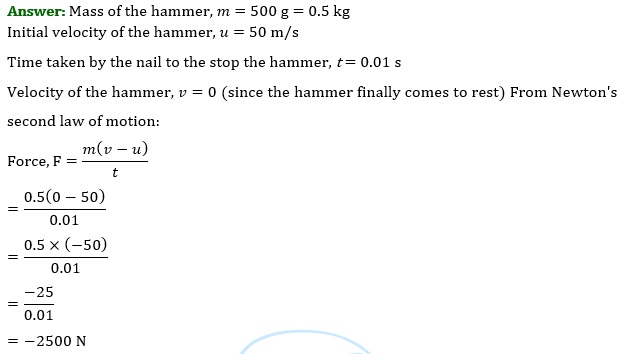
The hammer strikes the nail with a force of -2500 N. Hence, from Newton’s third law of motion, the force of the nail on the hammer is equal and opposite, i.e., +2500 N.
Question A4: A motorcar of mass 1200 kg is moving along a straight line with a uniform velocity of 90 km/h. Its velocity is slowed down to 18 km/h in 4 s by an unbalanced external force. Calculate the acceleration and change in momentum. Also calculate the magnitude of the force required.
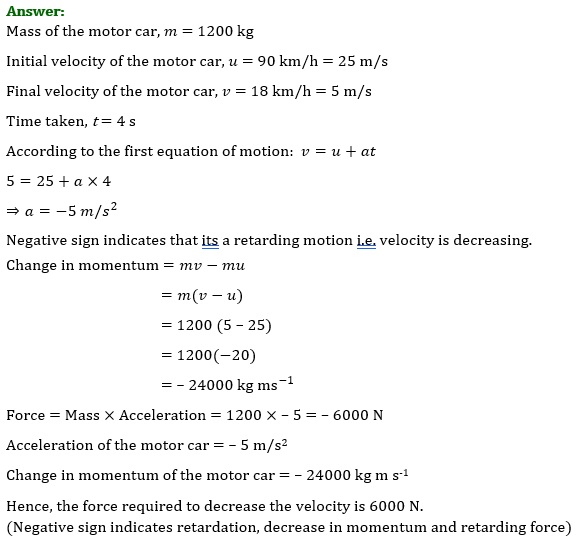
Question A5: A large truck and a car, both moving with a velocity of magnitude , have a headon collision and both of them come to a halt after that. If the collision lasts for 1s:
(a) Which vehicle experiences the greater force of impact?
(b) Which vehicle experiences the greater change in momentum?
(c) Which vehicle experiences the greater acceleration?
(d)Why is the car likely to suffer more damage than the truck?
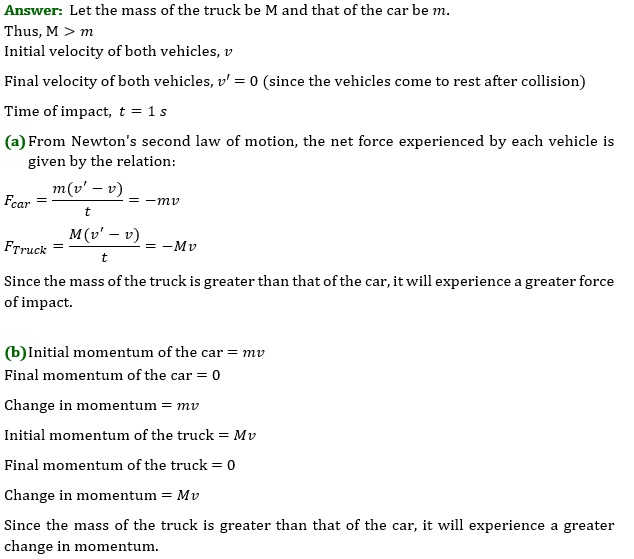
(c) From the first equation of motion, acceleration produced in a system is independent of the mass of the system. The initial velocity, the final velocity, and the time of impact remain the same in both cases. Hence, both the car and the truck experience the same amount of acceleration.
(d) According to Newton’s third law of motion, for every action there is an equal and opposite reaction that acts on different bodies. Since the truck experiences a greater force of impact (action), this larger
Class 9 Science NCERT Solutions Chapter 9 Force and Laws of Motion
CBSE Class 9 Science NCERT Solutions Chapter 9 helps students to clear their doubts and to score good marks in the board exam. All the questions are solved by experts with a detailed explanation that will help students complete their assignments & homework. Having a good grasp over CBSE NCERT Solutions for Class 9 Science will further help the students in their preparation for board exams and other competitive exams such as NTSE, Olympiad, etc.
NCERT Solutions for Class 9 Science Chapter 9 PDF
Below we have listed the topics discussed in NCERT Solutions for Class 9 Science Chapter 10. The list gives you a quick look at the different topics and subtopics of this chapter.
| Section in NCERT Book | Topics Discussed |
|---|---|
| 9.1 | Balanced and Unbalanced Forces |
| 9.2 | First Law of Motion |
| 9.3 | Inertia and Mass |
| 9.4 | Second Law of Motion |
| 9.5 | Third Law of Motion |
| 9.6 | Conservation of Momentum |